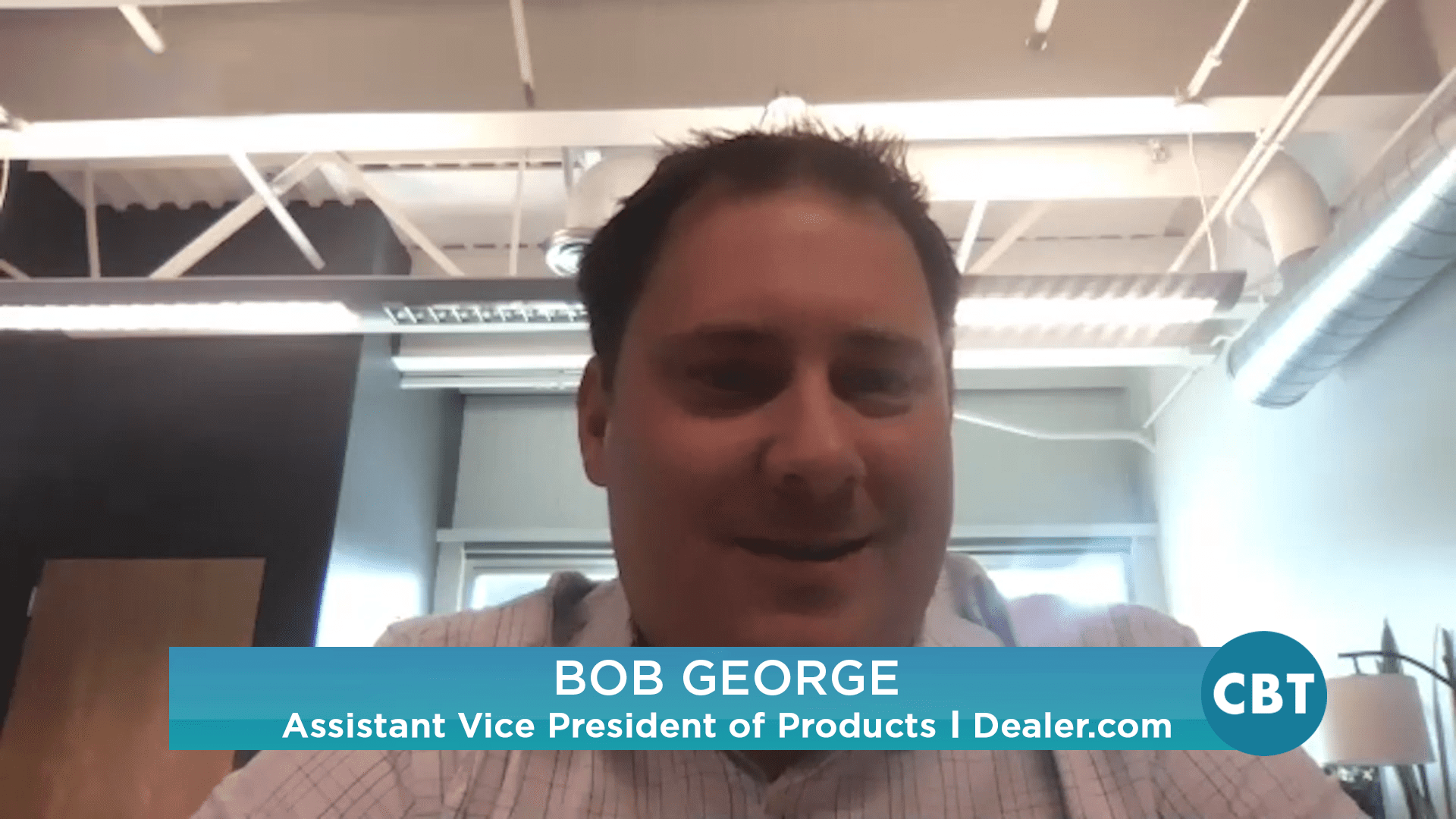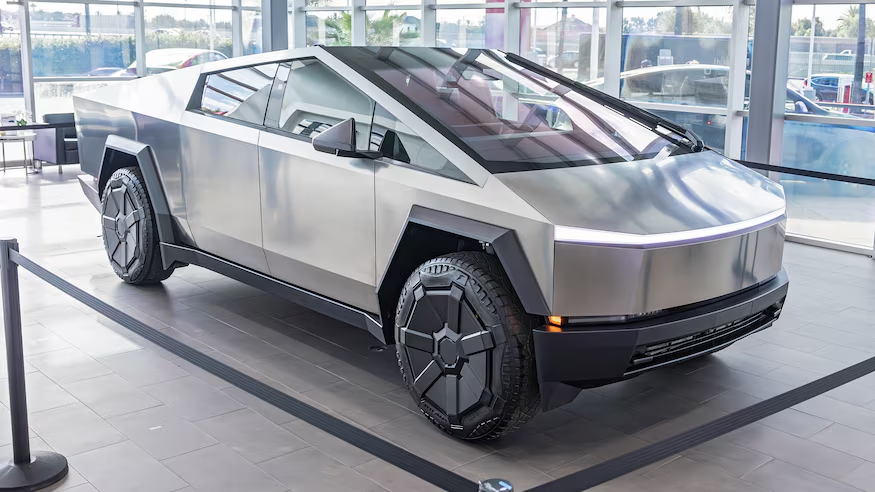According to The Cox Automotive 2019 Car Buyer Journey Study, consumers spend an average of 14 hours researching vehicles online before making a purchase. However, the websites that car buyers visit most often are heavily dependent on the quality of user experience. Here to tell us how dealers can incorporate targeted consumer data into their website design is Bob George, Assistant Vice President of Products at Dealer.com.
Jim Fitzpatrick: Hello everyone. I’m Jim Fitzpatrick. Thanks so much for joining us. Another edition of CBT News today. We’re so happy to have with us, Bob George, who is assistant vice president of products at dealer.com. I know that you know that brand. They’ve been around forever, for as long as dealers have been doing websites, dealer.com has been right there. Welcome into the show, Bob.
Bob George: Thanks so much. I appreciate it.
Jim Fitzpatrick: Or I should say welcome back into the show, Bob.
Bob George: That’s right.
Jim Fitzpatrick: You’ve joined us before, so welcome back. Talk to us about some of the things that, from your perspective, that dealers, for those dealers out there shopping for a website provider, what are some of the things, if you had to pick three or four items that dealers really need to focus on and make sure that provider can provide them in their new website?
Bob George: Yeah, the way we kind of think of it is, websites fundamentally are still trying to answer questions that car shoppers have had for decades, which is what car should I buy? And what dealers should I work with? And those questions, we encourage our teams and when we work with our customers, let’s make sure the sites and the technology we’re putting forward isn’t just technology but actually answers those questions. If I’m out shopping for a website, one of the things I’m doing is asking my providers, tell me how you’re listening to what consumers are asking and listening to the data to provide a better user experience on the website.
Bob George: Because if you think back, go back 20 years when dealer.com was founded and the website was about being a catalog of information online that if you went to the store and you walked the lot, you could see all the cars. Now the same is true of the website. Website wasn’t, is somebody coming out and asking you, “Well, how can I help you find a car? What are you looking for? What are your needs?” And so a website today needs to be something that listens and pays attention to what the shopper’s asking, and then puts forward a recommendation based on their needs, not just based on what they think they should sell them.
Jim Fitzpatrick: And now with digital retailing lurking around the corner where dealers are trying to get their hands around what that really means and are we going to be selling cars completely on the internet or through our website? A dealer’s website is now more important than it’s ever been because that’s where the journey begins with the client, right?
Bob George: Yeah, absolutely. It kind of begins and ends there too. Because more and more you see, for years again, what was the job with a website? It was to try to get people to walk inside the dealership. That’s still the job, but more and more the job of the website is to bring the dealership out to the customer and meet them at home, at work, wherever, and let them do more and more online. Bring that storefront to the user.
Jim Fitzpatrick: You’ll see some dealers that will have a website that they’ve had for the last four or five years and really haven’t had much, many updates or refresh or they just been happy with it and they feel they sell a bunch of cars and they haven’t made many changes on their website. How often does a website need to be freshened up or redesigned?
Bob George: That’s a great question. We debate this a lot because if you redesign it every month, there’s no continuity in the experience for people. And they come back and they think, what is this even the same place I was? But if you let it go for three, four or five years. We try to think in that 12 to 18 month range where, and the other thing to think about is we don’t think of design as a one, drop everything and launch a new design. You’re always kind of progressively enhancing. And we’re always testing on our platforms. You may have to make changes every week or every couple of weeks because of the testing we’re doing. And the design kind of evolves more. But for dealers who are a couple years back we say, “Hey, it’s time to raise up and get on the latest because this is all the data that’s informing this design based on behavior now not behavior before.”
Jim Fitzpatrick: Sure. Talk to us about this data driven approach when designing websites. Everything is now, it’s all about data. It’s almost like the auto industry and auto sales has become one big data play. Talk to us about that.
Bob George: I think it’s funny that from a data standpoint, a lot of people talk about all the data that they have and I think that’s great that they have it. What are we doing about it? And how are we turning it into something actionable and something that’s going to drive car sales and service and relationship? Dealer.com’s approach is kind of twofold. Number one, with the number of websites we have and the number of advertisers we have, we have more data than any other provider in this space. We’re able to very quickly validate assumptions, if I do this as a better than this? AB testing and that sort of thing. It’s really part of our culture here is to always be testing and we can get to a significant picking sample pretty fast because of our volume.
Bob George: But the AB testing piece is only the first piece because I always think, if I’m right here I can kind of optimize against that, but how do I know what’s over here that might take me a long time to get to in those tests? And so we spend a lot of time actually talking to car shoppers as well and asking them questions like what is it that the website, what are the unmet needs on the websites today? And not just dealer.com but across everything, the tier one sites, some of the listing sites. What are the things that you wished that website could do or the things where you keep getting hung up?
Bob George: And that actually informs a lot of our future direction because again, we can optimize a widget or an experience or something like that, but if there was a fully unmet need, one of the things we’re working on now is a comparison capability where you can actually much better tell the differences between the build of a car and then what I’m getting from my payment. Why is one $600 a month and another $800 a month? I can’t even tell the difference. Walk me through the value of that difference and let me decide is it worth the extra money or not? That was something that emerged as this major unmet need of all these websites. Everyone wanted us to buy a car online. No one was really helping me figure out what the difference between these two are that I’m interested in.
Jim Fitzpatrick: What other type of data is dealer.com analyzing in the website design process?
Bob George: Yeah, the kind of high level is that behavioral data like we talked about, which is just, the clicks and the submissions and the browsing and all that, all those signals that point to how people are using. And then, you can call it qualitative data, you can call it attitudinal data, that’s essentially the questions that, help me understand what the site is doing and not doing for you. Where are the roadblocks? What’s confusing to you? What makes sense? What are the experiences that make more more sense to you? And really when you put the two together, they’re all data points. Some are more quantitative hard metrics, some are more qualitative interview based. But at the end of the day, they all contribute to a story.
Bob George: And what’s interesting is a lot of the times the clicks and the scrolls and everything follow the story that we’re told in person because their behavior matches what they’re expressing as working or not working on the websites.
Jim Fitzpatrick: And how does dealer.com incorporate this data into their website design platform?
Bob George: Yeah, we really take it to heart and challenge and say, “Let’s not just build something that everyone thinks it looks cool and might demo well at NADA, but let’s make sure we’re solving.” And we do all that stuff too. Let’s make sure we’re solving real consumer problems and providing real pathways for consumers because at the end of the day, the consumer will drive all of this from a success standpoint. If we model them first and say what’s good for the consumer is good for the dealer. And so it is kind of a hybrid because sometimes you find something new and exciting and innovative in that data. Sometimes it’s just the rigor of making sure your experiences are following best practices and we’re not letting people configure things that violate or go against those.
Jim Fitzpatrick: What are some specific insights dealer.com’s data has yielded in terms of how dealer websites can best target and engage consumers?
Bob George: Yeah. I’ll tell you a story about when we just went through a big launch of our new vehicle details page. What always killed me, and this again wasn’t just dealer.com it was everybody. I’m looking at a $60,000 car and I’m looking at a picture that’s that big, and I’m supposed to be sold on it and start digital retailing. We rolled out a whole new VDP to, we’ve got 10,000 dealers now. We’ve rolled it out over the course of the summer actually. And we really had this kind of make the car the star mentality. If you’re going to sell that car on it, the big photos the much better options and packages display, clearer pricing display. One of the really interesting things when we were doing our research that we found is we looked at all the click data on the old VDPs and said, “Where are people clicking into the most?” And when you get aside from e-price and and digital re-time, one of the top click things we found on the website was view window sticker.
Bob George: And what we realized there is if someone’s clicking to view the window sticker and they want to see the options and packages breakdown and they want to see all the op codes and everything, they’re not getting that on the website. And that’s what’s forcing them to click view window sticker. We designed our entire experience around, I said to the team, “Let’s make, let’s actually have fewer people click on view window sticker with the new one because they’re getting that experience from the new VDPs.” And that’s come true.
Bob George: We’ve also seen leads increase because of it. And so, and the funny thing there is in a lot of those we removed, there were some sites that had 10 or 11 calls to action on the VDP. We knocked it down to two or three and leads went up.
Jim Fitzpatrick: Wow.
Bob George: And you think, well why is that? Why? I think I know why. Because it’s easier, it’s simpler. Go to apple.com, they have one call to action, buy this phone. That’s the sort of spirit we had to bring.
Jim Fitzpatrick: Make it pretty simple.
Bob George: Yeah, and we struggle when people, we talk about design and anytime there’s a little bit of white space, I’m going to put another button there, another banner there, another call to action.
Jim Fitzpatrick: I know, I know.
Bob George: Let it breathe. And just see them when you’re at the dealership. Don’t constrict me with a whole bunch of things around me. Just let me experience the car myself.
Jim Fitzpatrick: Bob George, assistant vice president of products at dealer.com. I know you’re one busy guy. Thank you so much for joining us on CBT News. Been very enlightening and hopefully we’re going to have you back to talk more about this.
Bob George: I’d love to, thanks so much. I appreciate it.
Jim Fitzpatrick: Thank you.
CBT Automotive Network. The number one most-watched network in retail automotive. This has been a JBF Business Media production.









